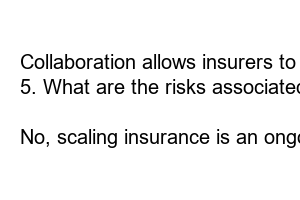스케일링 보험
Title: Scaling Insurance: Securing a Bright Future
Subheadings:
1. The Importance of Scaling Insurance
2. Understanding the Challenges of Scaling Insurance
3. Strategies for Effective Insurance Scaling
4. Embracing Technology: The Key to Agile Scaling
5. Leveraging Data Analytics to Drive Scalability
6. The Role of Collaboration in Insurance Scaling
7. Summary: Unlocking Growth Potential
Blog Post:
The Importance of Scaling Insurance
Every successful business understands the need to scale, adapting and expanding to meet growing demands. Insurance is no exception. Scaling insurance operations is vital to ensure sustainable growth, enhanced efficiency, and improved customer experiences. As insurance needs evolve, companies must be prepared to scale their services proactively.
Understanding the Challenges of Scaling Insurance
Scaling insurance can be challenging, with a myriad of factors that can hinder progress. **Limited resources**, inefficient processes, and compliance issues often act as roadblocks. Additionally, traditional practices and outdated systems may create bottlenecks, hampering the ability to meet expanding customer demands.
Strategies for Effective Insurance Scaling
1. **Streamline Processes**: Eliminate unnecessary bureaucratic procedures and optimize workflows to reduce complexities and enhance operational efficiency, enabling better scalability.
2. **Invest in Talent**: Cultivate a workforce focused on innovation, agility, and adaptability. Hiring skilled and experienced professionals is crucial in achieving scalable growth.
3. **Enhance Customer-Centricity**: Understand and anticipate customer needs through comprehensive research and analysis. Tailor products and services to meet evolving customer demands, fostering loyalty and attracting new business.
Embracing Technology: The Key to Agile Scaling
Adopting modern technologies and embracing digitization is essential for scaling insurance. Automation, artificial intelligence (AI), and machine learning (ML) solutions empower insurers to streamline operations, reduce costs, and improve customer engagement. Digital platforms facilitate seamless communication and offer self-service options, ensuring a frictionless experience for policyholders.
Leveraging Data Analytics to Drive Scalability
**Data analytics** is a game-changer in the insurance industry. By harnessing the power of data, insurers can gain valuable insights into customer behaviors, patterns, and preferences. These insights enable targeted marketing strategies, product innovation, and efficient resource allocation, maximizing scalability.
The Role of Collaboration in Insurance Scaling
Mutually beneficial collaborations between insurers, reinsurers, insurtech startups, and other industry stakeholders are instrumental in scaling insurance. Collaborative efforts foster innovation, knowledge-sharing, and resource pooling. By leveraging the expertise and capabilities of multiple parties, insurers can accelerate their scaling efforts.
Summary: Unlocking Growth Potential
In a rapidly changing insurance landscape, scaling is pivotal to ensure long-term business success. By streamlining processes, investing in talent, prioritizing customer-centricity, embracing technology, leveraging data analytics, and fostering collaboration, insurers can overcome challenges and unlock their true growth potential.
FAQs:
1. How does scaling insurance benefit policyholders?
Scaling insurance benefits policyholders by ensuring improved customer experiences, streamlined processes, and tailored products and services that meet evolving needs.
2. What technologies should insurers adopt to drive scalability?
Insurers should adopt technologies such as automation, AI, ML, and digital platforms to drive scalability and enhance operational efficiency.
3. Can data analytics help insurers identify new market opportunities?
Yes, data analytics can provide valuable insights into customer behaviors and preferences, helping insurers identify new market opportunities and develop innovative products.
4. How does collaboration facilitate insurance scaling?
Collaboration allows insurers to tap into the expertise and resources of multiple stakeholders, accelerating innovation, knowledge-sharing, and scalability efforts.
5. What are the risks associated with scaling insurance?
The risks associated with scaling insurance include compliance challenges, resource limitations, and potential disruptions to existing processes. However, these risks can be mitigated through careful planning and strategic execution.
6. Is scaling insurance a one-time effort?
No, scaling insurance is an ongoing process that requires continuous adaptation, innovation, and investment in order to meet the changing needs of the market and policyholders.

